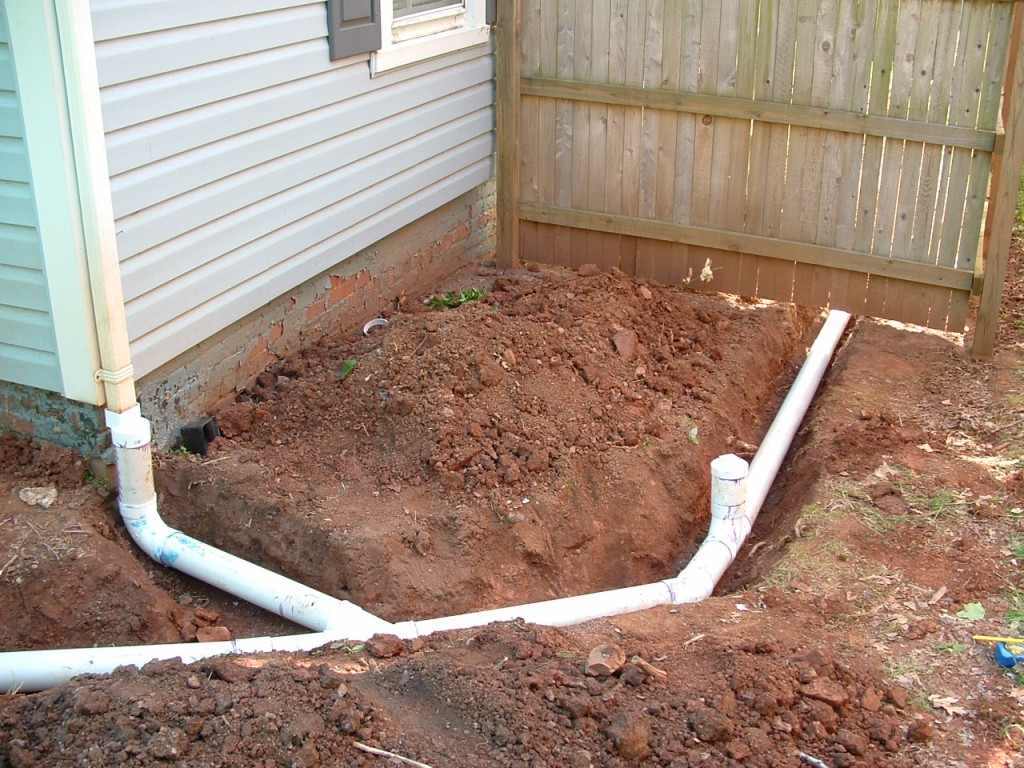
Last night I signed contracts with some great folks, and they asked me to add some drainage work while the crews are out there. We walked out to look at what was going on, and as usual I was appalled. When their patio was installed, the contractor connected the downspouts on the rear of the house to 4″ corrugated drain pipe. These come together in a “Y”, and then a short piece goes out to a low spot in the yard. Here, the pipe turns straight up and is covered with a grate flush with the lawn.
Hmm. So when it rains, water burbles up out of this contraption and pools at the corner of the screen porch for a couple of days. Plus, all the rainwater at the back of the house is being brought together into a single 4″ pipe. Idiots. So in the interest of breathing some common sense into landscape and drainage design, here are some points to ponder:
- Water flows downhill. Elementary, my dear Watson, but often overlooked. Don’t terminate a drainpipe in a flat area if five more feet lets you terminate on a slope. And remember to keep a constant pitch downhill!
- Corrugated pipe is fine, but smooth-bore is better. We’re usually gently pitched when running drain lines away from the house, which means the water isn’t moving super fast. That means sediment and funk from the roof can get stuck in the ribs of corrugated pipe and eventually clog. An even bigger issue is that smooth PVC drainpipe is rigid, so it’s easier to keep it pointed downhill. Corrugated pipe will conform to the ground around it, so after settling and a few years of frost there are uphill sections. See point # 1.
- 4 + 4 + 4 +4 does not equal 4. All too often I see companies hook 4 or 5 downspouts together into one 4″ pipe. Guess what? That’s a lot of water, and may well be too much for the pipe. If you add water to a funnel faster than it can drain out, what happens? If you want to get an idea of how much water comes off your roof in one storm, there’s a cool rainfall harvest calculator on this page.
- Pop-ups are ok, but daylight is better. Pop-up emitters serve a purpose. If you have to end a drain line in the grass, a pop-up emitter keeps you from destroying the line with your mower. It’s also a mechanical system that can fail. If the site allows it, you’re better off ending with the open end of the pipe pointed downhill – what we call “daylighting”.
- Be a good neighbor. This one’s pretty huge. Think about where your water is going if you move it to a discharge point out in the yard. If you’re in a subdivision where water moves through the backyards, what does it do to your neighbors if you build raised beds and block that flow? Not only is it rude and crappy, it’s often illegal to alter the drainage in a way that adversely affects your neighbor. Just food for thought.
Drainage doesn’t have to be overly complicated, but it’s definitely worth planning properly. Most residential systems won’t fail this spectacularly, but why risk it?

I agree that there are many cases where landscape designers install lousy drainage systems – but as a landscape designer I am appalled at how often builders and developers do. As the originators they have the opportunity to prevent most problems in the first place. I can’t correct drainage when the land was overdeveloped with no thought given to drainage, the property has no grade, and the water has no escape.
I will also never understand why builders (in my area anyways) terminate the front downspouts into the tiny foundation bed between the house and the newly poured concrete sidewalk, would a 4′ piece of pipe cost too much to install beneath the walk so that water could at least exit on the other side?
Sharon – sorry for the delay in moderating, and responding to, your comment. Long day on the road. Anyhow, thanks for commenting. Love your site and your work!
Don’t even get me started on builders. You have to recognize that they think in enormous economies of scale. Yes, let’s say that labor and materials to run a 4″ line under the walk costs them $50 (just making up a # here). You and I look at it and say “in the scheme of a $400,000 home, no biggie.” The developer looks at it as “$50 x 1,000 homes in this subdivision = $50,000 I can save by making it the next person’s problem.” I don’t like it, but I get it. It’s why I love working with custom builders, because they’re looking at that job alone (mostly).
For a DIY homeowner what options for smooth pipe do I have other than pvc? Is there any flexible and smooth pipe option? TIA!
Forgot to mention this is for above ground